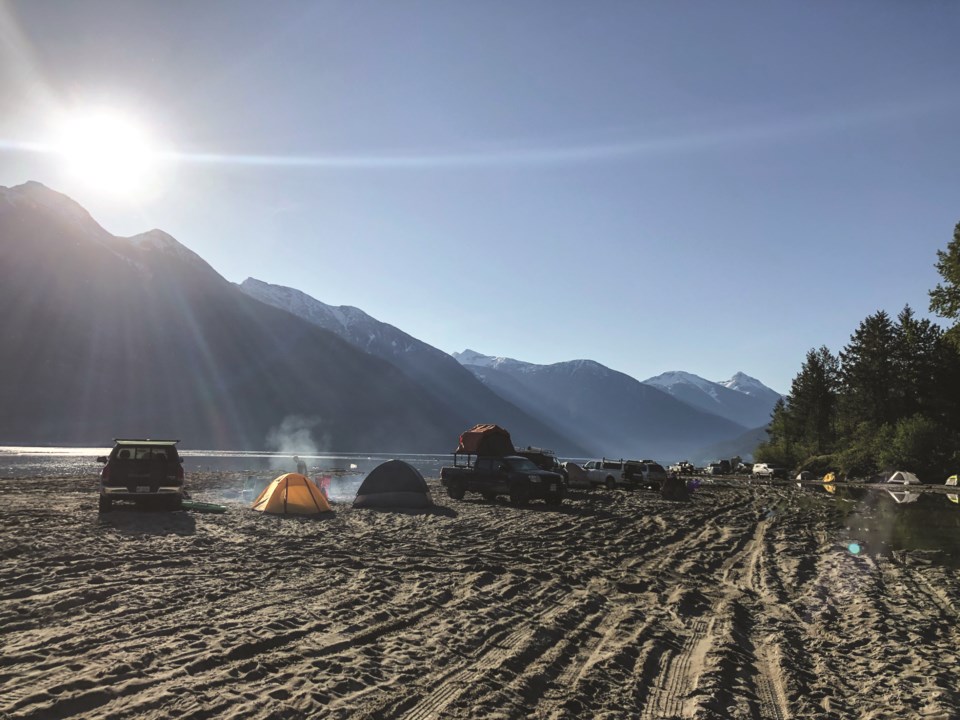Since the start of the pandemic last spring, crowds of campers and partiers have been driving trucks, cars, and ATVs onto the sand bars in the Pemberton Wetlands Wildlife Management Area.
The problem? The 750 hectares of fish and wildlife habit along the Lillooet River is both environmentally sensitive and a culturally significant location for the Lil’wat Nation.
Ahead of what’s poised to be another summer of people clamouring for outdoor activity, the Pemberton Wildlife Association (PWA) and the Nation are hoping to spread the word that the area was never meant for vehicles, camping, or campfires.
“There’s different values there,” said Chief Dean Nelson, political chief of the Lil’wat Nation. “It has become a value for people to seek their own private place, but there’s a lot of [spiritual and cultural] value there they maybe don’t know about. Or if they do know, it’s whether or not they’re respecting it at all.”
That includes burial sites and some pictographs (though some of those have been blasted off rock faces by the forest industry, Nelson added).
The two problem areas have been near the Green River and at the confluence of the Lillooet River and Lillooet Lake.
Last June, the PWA wrote a letter to Doug Donaldson, then-Minister of Forests, Lands, Natural Resource Operations and Rural Development, outlining the problem and asking for an update to the management plan for the area.
“The update should include an assessment of all the areas vulnerable to increased recreational pressures,” it read. “Some strategies to consider in the updates will be access management, public education and awareness, designated use areas, restrictions, and enforcement mechanisms.”
The ministry responded and, last summer, sent a contractor to deter access. “I don’t think it was robust enough for the determined [visitor],” said Veronica Woodruff with the PWA. “There was a bit of work done, but it didn’t hold up.”
On a recent weekend, she observed several dirt bikes in the area.
“There are people who know about these places locally, but there are others on an adventure,” she said. “Last year, everyone was stuck inside, then they flooded that first week. We’re kind of in the same boat again … Managed camping isn’t available, which is harder on these wild spaces.”
Woodruff will sometimes go and talk to campers to find out more about how they discovered the area and gauge what their knowledge is of the ecosystem.
“I don’t think it’s malicious,” she said. “People aren’t doing it because they know and don’t care. I think they don’t know.”
One lesson they do quickly learn? In the spring, especially, the warm weather can trigger alpine melt, which leads to the river rising up to two metres, which has resulted in many people either waking up to wet tents or finding their vehicles stranded.
“People just don’t realize it,” she said. “They get there Friday night and say, ‘Look at all this sand.’ [I’ve seen] cars stuck on the other side of the channel at 7 a.m.”
One example of the problem vehicles in the area can cause is the impact on newly hatched salmon. “If you’re coho and you just emerged from the gravel, that’s where you’re going to go [in shallow river water]. The water is warmer, it’s newly wetted, you’re swimming for the first time, you’re in these shallow areas along the edge of the shoreline. There’s physical damage, but then there’s also the potential for other types of deleterious substances [like fuel],” Woodruff said.
The goal isn’t to ban people from the area, but rather restrict cars, camping, and fires. “We don’t want to stop people from going there,” Nelson said. “It’s a beautiful area. We just want to educate people.”
Woodruff echoes that sentiment. “I’m OK with people walking in there and enjoying the view and having a picnic because it’s a really beautiful area,” she said. “You can get an appreciation of those components we’re trying to protect.”
In the end, Woodruff said she’s hopeful that the PWA, Lil’wat Nation, and provincial government will be able to come up with solutions.
“The best thing right now, like any initiative that’s successful, is these partnerships,” she said. “With having the Nation onside and the wildlife association and the province working together, I have high expectations. I think we can accomplish a lot with very little if we’re working together.”






